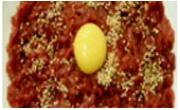In 1999, Do Ho Suh created a life-size replica of his childhood home using gauzy, translucent green silk. Entitled Seoul Home/L.A. Home/New York Home/Baltimore Home/London Home/Seattle Home/L.A. Home, the work has largely been assessed as the artist...
http://chineseinput.net/에서 pinyin(병음)방식으로 중국어를 변환할 수 있습니다.
변환된 중국어를 복사하여 사용하시면 됩니다.
- 中文 을 입력하시려면 zhongwen을 입력하시고 space를누르시면됩니다.
- 北京 을 입력하시려면 beijing을 입력하시고 space를 누르시면 됩니다.
https://www.riss.kr/link?id=A109734108
-
저자
이재희 (한국학중앙연구원)
- 발행기관
- 학술지명
- 권호사항
-
발행연도
2025
-
작성언어
Korean
-
주제어
Do Ho Suh ; site-specific art ; New Figuration ; figure ; figuration ; NAMES Project ; AIDS Memorial Quilt ; needlework ; cloth ; clothing ; 서도호 ; 장소 특정적 미술 ; 새로운 형상성 ; 형상 ; 네임즈프로젝트 ; 에이즈메모리얼퀼트 ; 바느질 ; 천 ; 옷
-
등재정보
KCI등재
-
자료형태
학술저널
-
수록면
178-207(30쪽)
- DOI식별코드
- 제공처
-
0
상세조회 -
0
다운로드
부가정보
다국어 초록 (Multilingual Abstract)
In 1999, Do Ho Suh created a life-size replica of his childhood home using gauzy, translucent green silk. Entitled Seoul Home/L.A. Home/New York Home/Baltimore Home/London Home/Seattle Home/L.A. Home, the work has largely been assessed as the artist’s strategic incorporation of Koreanness amid a surging interest in multicultural discourse. Seoul Home, however, was an audacious attempt to rethink the possibilities and limitations of the existing mode of site-specificity. According to Suh, once a site-specific work is removed from its original location, it may no longer offer a phenomenological experience of the place. Yet this severance can open up the possibility for the work to act as a sculptural object that evokes the memory of that place. More significantly, as the piece travels, it gestures toward the lingering discursive specificity of each city, even within the abstract, homogenized space of late capitalism. This article, the first in a two-part study, traces how Suh reconfigured Seoul Home as a mnemonic device through his engagement with the figuration discourse of 1980s Korean art and the commemorative logic of the NAMES Project AIDS Quilt in early 1990s America. In doing so, it proposes a new model of site-specificity—one that foregrounds mobility as a mnemonic and spatially generative force.
동일학술지(권/호) 다른 논문
-
- 미술사와 시각문화학회
- 장진성
- 2025
- KCI등재
-
판화에서 산수로: 17세기 실경산수화의 전환과 정선의 금강산도
- 미술사와 시각문화학회
- 이경화
- 2025
- KCI등재
-
심주(沈周)의 <여산고도(廬山高圖)>: 15세기 소주(蘇州)의 서원(書院)과 문인 감상자층을 위한 회화
- 미술사와 시각문화학회
- 송창묵
- 2025
- KCI등재
-
- 미술사와 시각문화학회
- 오윤정
- 2025
- KCI등재





 KCI
KCI KISS
KISS






